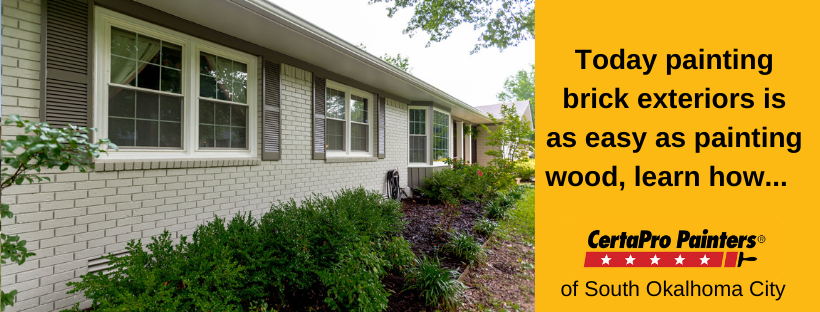
Don’t be afraid to paint the brick on your house
Posted on May 2, 2021
Painting a Brick, brick front, or partial brick Home
In and around the suburbs of Oklahoma City it’s not uncommon to find homes clad partially or entirely in brick. If you have brick on the outside of your home, you might think there is little to do to update it. While it’s a timeless and earthy architectural feature, it can make your house look too similar to every other brick house in your neighborhood. Whether it’s a brick front or brick on the bottom of your exterior when you decide to paint you are only limited by your imagination. Stains and paints have been created in the last few years to work well with the porous material. These allow you to use color to make your house reflect your personal style.
Many people assume changing the brick is as simple as painting an exterior wall clad in wood. The job is a bit more complicated than that. In addition to basic painting skills and tools, you must know that there are five things to consider before getting started.
Painted brick is relatively permanent
Most of the time, paint can be changed and removed fairly easily. With brick, this isn’t really the case. To put the brick back to its original state after painting, you’ll have to go through a complete restoration process. This sort of process requires specialized knowledge, tools, and products. Before you decide to paint your brick, be fully prepared to commit to the color and choices you make. Restoration can be cost-prohibitive for many homeowners.
Root causes of water damage must be detected and prevented before painting
You must thoroughly look for signs of water damage or intrusion before starting. Damp spots, mold, or any other water-based issues are signs of an underlying issue. Adding paint over it will only seal in the problem and cause more damage to occur. This can also damage the paint you put on by causing it to peel and fall off. If your bricks are damp, work with products that will allow the masonry to continue to breathe and allow the water to escape. Consult with professionals if you have any concerns about underlying water issues before you begin this project.
Efflorescence is a common problem in brick
Inside the brick and mortar are water-soluble salts. As the water evaporates, the salt stays behind on the walls creating efflorescence. This happens when the bricks aren’t sufficiently prepared before a finish or sealant was applied. Our painters are experienced in dealing with correcting problems from previous paintings. They also are skilled in preparations before painting or staining brick to avoid future issues. For example, it’s imperative to inspect and clean brickwork before beginning work. Our teams know this and will not cut any corners.
Excessive alkalinity can damage the paint
When painting brick, alkalinity can also damage the final results. Bricks are typically neutral but the mortar around them contains soluble mineral salts, which are alkalis. Free alkalis will lead to the breakdown of oil-based paint and films. This process is called “saponification”. Applying the correct primers can prevent this sort of failure in the paint.
On-going maintenance is necessary
The painted brick will require regular maintenance. Keeping your painted bricks in good condition will provide protection against failure and the elements. When working outside, taking sun exposure and UV Rays into consideration is important. Once the paint begins to fade, you’ll need to consider repainting to protect the walls. One way to avoid frequent repainting is to prime appropriately and choose a lighter color like off-white or a light natural neutral color.
That sounds like a lot to worry about but it’s actually not
For professionals, the entire process is something that simply requires the correct process and prep work. Having the know-how and access to the proper paint products makes all the difference. Is it a possible DIY project? Maybe, it’s better left in the hands of people with training and expertise. Once you do decide to do it however it opens up a world of color options you never had before.
The good news is you get more options than ever
Not everyone loves the dark earthy look of brick, so knowing you aren’t trapped as far as color options are concerned you can go ahead and paint it nearly any shade you like. Some colors look especially good on brick. Grays and shades of white leverage the unique texture of brick and add real character to the finished look. Shades of blue also work along with nearly any shade of tan.
Schedule an Estimate
If painting your exterior bricks is in your plans but you don’t want to take a course in DIY prep work before starting, call us! We have experienced teams ready to take on the project for you. Schedule a free, no-obligation estimate with CertaPro of South Oklahoma City, and let’s discuss your project.





